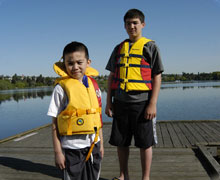Water Safety for Children With Epilepsy or Seizures
C
You can download this article as a PDF (English, Amharic, Arabic, Russian, Simplified Chinese, Somali, Spanish, Vietnamese).

Children with epilepsy or seizures have a much greater risk of drowning than other children. This is especially true for children 5 years of age or older. The most common place where children and adults with epilepsy drown is in a bathtub. Swimming pools are also places where seizures are likely to lead to drowning. Most drowning events are silent and happen within minutes.
Here are some ways to keep your child safe around water.
Bath Time
- Give your baby constant touch supervision while they are in the bathtub.
- Stay in the bathroom at all times when your young child is in the bathtub.
- Start training your child to shower by using a handheld sprayer in the bathtub with no standing water, and the drain open.
- When your child is old enough to want to bathe alone, they should shower, not take baths. Baths are not recommended for people with seizures. Showers are safer.
- Keep the bathroom door unlocked and open.
- If your child falls often during seizures, consider using a tub seat with a safety strap.
Swimming
- Ask your child’s doctor whether your child’s seizures are under enough control to allow swimming.
- Enroll your child in swimming lessons. Tell the teacher your child has epilepsy or seizures.
- Swim with your child, or require that your child be with someone who swims well enough to help if your child has a seizure while in the water. The person with your child needs to be strong enough to lift them to safety if needed. Make sure your child only swims in water that is shallow enough for the person to be able to stand on the bottom while helping your child.
- Make sure that your child swims in a supervised pool. Tell the life guard that your child has epilepsy or seizures and be sure that an adult who is responsible for only watching your child is there as well.
- Avoid swimming in open water, like lakes or rivers, unless your child is well supervised and wearing a life jacket.
- Have your child wear a brightly colored swimsuit and life jacket so they are easier to see.
Boating
- Always have your child wear a life jacket when on a boat, raft, dock or close to water.
- Make sure that adults in the boat wear life jackets as well to set an example and be better prepared in an emergency.
- Have your child seated in the boat, not on the edge.
- If you can, carry a cell phone in case of emergency.
Other Water Safety Tips
- Check your home for drowning hazards, such as ponds and cisterns.
- Empty buckets and wading pools and store them upside down when they’re not in use.
- Keep the toilet lid down.
- Keep the bathroom door closed (except during a bath or shower).
- Set your water heater to 120° F (49º C) or lower, or between low and medium. If you can’t control the heater, install anti-scald devices on your faucets and showerheads. These stop the water from flowing when it is hotter than 120º F.
- Make sure shower and bath drains run quickly and are not covered with items.
- Make sure your child is supervised at all times in a hot tub.
- Have your child wear a life jacket when near ponds, lakes, rivers or the ocean.
- Learn CPR.
- Ask your child’s nurse or doctor for special tips to keep your child safe around water.
If a Seizure Occurs in the Water
- Support your child’s head and keep their face out of the water.
- Bring them to the shore or side of the pool, and place them on their side once they are out of the water.
- Check their airway and breathing. If breathing is labored or noisy, or your child is not alert, call 911.
- Give CPR if needed.

